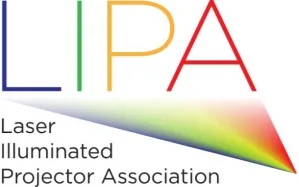We recently published a Display Daily (US Laser Phosphor Projectors Sales in Jeopardy Because of FDA Ruling) by Chris about the issues for laser phosphor projectors in the US, following FDA guidance. The Laser Illuminated Projector Association wrote to us to give us its view.
July 27, 2015
Dear Chris,
In response to your recent article, LIPA would like to offer its perspective of several issues raised by the U.S. Food and Drug Administration’s Center for Devices and Radiological Health (FDA/CDRH) February 2015 Laser Illuminated Projector (LIP) Guidance.
Creating a regulatory environment that regulates laser-illuminated projector systems (LIP systems) based on scientific fact is an ongoing process for LIPA and the FDA/CDRH. LIPA has provided comments and technical proof to the FDA/CDRH recommending LIP systems be treated exactly the same as lamp-based projectors since, as a scientific fact, they represent identical risk – as you correctly stated in your report.
Regarding the February Guidance document, several points should be taken into consideration by manufacturers, resellers, installers, and other users of laser-illuminated projectors:
- LIPA has urged, and will continue to urge, the FDA/CDRH to revise the 2015 LIP Guidance or issue new guidance that does NOT reference the older IEC 60825-1:2007, but rather references the newer IEC 60825-2:2014 and the newly-published IEC 62471-5:2015. We believe the incorporation of key language of these new international standards will allow for consistent regulatory oversight of LIPs appropriate for the wide-spread adoption of this revolutionary technology.
- In the meantime, it is LIPA’s belief that the February 2015 Guidance issued by the FDA does not bind the FDA or the public, in that it contains “non-binding” recommendations. LIPA believes that this means that LIPs manufacturers may, instead, choose to adhere to the underlying Code of Federal Regulations (CFR) or to the other guidance documents currently in place, namely Laser Notice 50. LIPA believes that:
- If a company chooses not to conform to the 2015 LIP Guidance, they must still adhere to the classification policies contained in the CFR, specifically, 21 CFR § 1040.10-11, for laser products. There is also the option for a LIPs manufacturer to adhere to the provisions of Laser Notice 50, another Guidance document containing non-binding recommendations, which provides a safe harbor against FDA regulatory enforcement action.
- Conforming to the CFRs and/or the still in-force Laser Notice 50 rather than adhering to the non-binding recommendations of the 2015 LIP Guidance, allows most consumer and business LIP systems, including laser phosphor projectors, to be sold and installed with the conventional laser product markings, but without variances or special mounting requirements.
- A point of clarification regarding Risk Groups (an IEC term): Risk Group classification is based on radiance measurements, not lumens, as your article incorrectly suggested. Please see IEC 62471-5:2015 for additional information on how to correctly assign a Risk Group.
While your article suggested that the 2015 Guidance could have a chilling effect on the industry, we hope this letter explains why LIPA considers this concern unwarranted and believes that there are avenues available today which allow for the safe sale, installation and use of LIP systems.
Thank you for the opportunity to clarify.
Heidi Hoffman, LIPA Managing Director
Disclaimer: Please note that the above reflects LIPA’s opinions on how best to navigate the current regulatory framework for LIP products and should not be construed as legal advice, which you can best obtain from an attorney with appropriate knowledge of FDA rules and regulations.
Laser Illuminated Projector Association • LIPA • 3081 Zanker Road • San Jose, California, USA
Tel: +1.408.577.1300 • Fax +1.408.577.1301 • www.LIPAinfo.org

